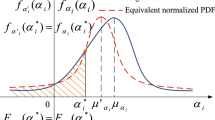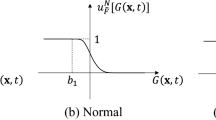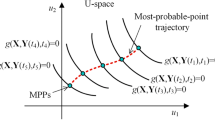Abstract
The ubiquitous uncertainties presented in the input factors (e.g., material properties and loads) commonly lead to occasional failure of mechanical systems, and these input factors are generally characterized as random variables or stochastic processes. For identifying the contributions of the uncertainties presented in the input factors to the time-variant reliability, this work develops a time-variant global reliability sensitivity (GRS) analysis technique based on Sobol’ indices and Karhunen- Loève (KL) expansion. The proposed GRS indices are shown to be effective in identifying the individual, interaction and total effects of both the random variables and stochastic processes on the time-variant reliability, and can be especially useful for reliability-based design. Three numerical methods, including the Monte Carlo simulation (MCS), the first order envelope function (FOEF) and the active learning Kriging Monte Carlo simulation (AK-MCS), are introduced for efficiently estimating the proposed GRS indices. A numerical example, a beam structure and a ten-bar structure under time-variant loads are introduced for demonstrating the significance of the time-variant GRS analysis technique and the effectiveness of the numerical methods.



Similar content being viewed by others
References
Andrieu-Renaud C, Sudret B, Lemaire M (2004) The PHI2 method: a way to compute time-variant reliability. Reliab Eng Syst Saf 84(1):75–86
Au SK (2005) Reliability-based design sensitivity by efficient simulation. Comput Struct 83:1048–4061
Au SK (2008) First passage probabilistic of elasto-plastic system by importance sampling with adapted process. Probabilist Eng Mech 23(2):114–124
Au SK, Beck JL (2001) Estimation of small failure probabilities in high dimensions by subset simulation. Probabilist Eng Mech 16(4):263–277
Borgonovo E, Plischke E (2016) Sensitivity analysis: a review of recent advances. Eur J Oper Res 248(3):869–887
Borgonovo E, Tarantola S, Plischke E, Morris MD (2014) Transformations and invariance in the sensitivity analysis of computer experiments. J R Stat Soc B 76(5):925–947
Campolongo F, Cariboni J, Saltelli A (2007) An effective screening design for sensitivity analysis of large models. Environ Model Softw 22(10):1509–1518
Chen JB, Li J (2005) Dynamic response and reliability analysis of non-linear stochastic structures. Probabilist Eng Mech 20(1):33–44
Chen JB, Li J (2007) The extreme value distribution and dynamic reliability analysis of nonlinear structures with uncertain parameters. Struct Saf 29(2):77–93
Cui LJ, Lu ZZ, Zhao XP (2010) Moment-independent importance measure of basic random variable and its probability evolution solution. Sci Chin Technol Sc 53(4):1138–1145
Drignei D, Baseski I, Mourelatos ZP, Kosova E (2016) A stochastic process metamodel approach for time-dependent reliability. J Mech Design 138(1):011403
Du XP (2014) Time-dependent mechanism reliability analysis with envelope functions and first-order approximation. J Mech Design 136(8):081010
Dubourg V, Sudret B (2014) Meta-model-based importance sampling for reliability sensitivity analysis. Struct Saf 49:27–36
Dubourg V, Sudret B, Deheeger F (2013) Metamodel-based importance sampling for structural reliability analysis. Probabilist Eng Mech 33:47–57
Echard B, Gayton N, Lemaire M (2011) AK-MCS: an active learning reliability method combing Kriging and Monte Carlo simulation. Struct Saf 33:145–154
Goswami S, Ghosh S, Chakraborty S (2016) Reliability analysis of structures by iterative improved response surface method. Struct Saf 60:56–66
Hasofer AM, Lind NC (1974) An exact and invariant first order reliability format. J Eng Mech 100:111–121
Homma T, Saltelli A (1996) Importance measures in global sensitivity analysis of model output. Reliab Eng Syst Safe 52:1–17
Hu Z, Du XP (2013) Time-dependent reliability analysis with joint upcrossing rates. Struct Multidiscip O 48(5):893–907
Hu Z, Du XP (2015) First order reliability method for time-variant problems using series expansions. Struct Multidiscip O 51:1–12
Hu Z, Mahadevan S (2016) A single–loop Kriging surrogate modelling for time-dependent reliability analysis. J Mech Design 138:061406
Huang XZ, Zhang YM (2010) Reliability sensitivity analysis for rack-and-pinion steering linkages. J Mech Design 132(7):071012
Jensen HA, Mayorga F, Papadimitriou C (2015) Reliability sensitivity analysis of stochastic finite element models. Comput Method Appl M 296(1):327–351
Jiang C, Huang XP, Han X, Zhang DQ (2014) A time-variant reliability analysis method based on stochastic process discretization. J Mech Design 136(9):091009
Li J (2016) Probability density evolution method: background, significance and recent developments. Probabilist Eng Mech 44:111–117
Li LY, Lu ZZ (2012) Moment-independent importance measure of input variable and its stat-dependent parameter solution. Struct Saf 38:40–47
Lu ZZ, Song SF, Yue ZF, Wang J (2008) Reliability sensitivity method by line sampling. Struct Saf 30:517–532
Pandey MD, Zhang XF (2012) System reliability analysis of the robotic manipulator with random joint clearances. Mech Mach Theory 58:137–152
Phoon KK, Huang SP, Quek ST (2002) Implementation of Karhunen- Loève expansion for simulation using a wavelet-Galerkin scheme. Probabilist Eng Mech 17:293–303
Poirion F (2016) Karhunen Loève expansion and distribution of non-Gaussian process maximum. Probabilist Eng Mech 43:85–90
Rice SO (1944) Mathematical analysis of random noise. Bell Syst Tech J 23(3):282–332
Sobol’ IM (1998) On quasi-monte carlo integrations. Math Comput Simulat 47(2):103–112
Sobol’ IM (2001) Global sensitivity indices for nonlinear mathematical models and their Monte Carlo estimates. Math Comput Simulat 55(1–3):271–280
Song SF, Lu ZZ, Qiao HW (2009) Subset simulation for structure reliability sensitivity analysis. Reliab Eng Syst Safe 94:658–665
Stefanou G, Papadrakakis M (2007) Assessment of spectral representation and Karhunen-Loève expansion methods for the simulation of Gaussian stochastic fields. Comput Method Appl M 196:2465–2477
Sudret B (2008) Analytical derivation of the outcrossing rate in time-variant reliability problems. Struct Infrastruct E 2008 4(5):353–362
Sudret B, Der Kiureghian A (2000) Stochastic finite element methods and reliability: a state-of-the-art report. Department of Civil and Environmental Engineering, University of California, Berkeley
Wang ZQ, Chen W (2016) Time-variant reliability assessment through equivalent stochastic process transformation. Reliab Eng Syst Safe 2016(152):166–175
Wang ZQ, Wang PF (2013) A new approach for reliability analysis with time-variant performance characteristics. Reliab Eng Syst Saf 2013(115):70–81
Wang ZL, Mourelatos ZP, Li J, Baseski I, Singh A (2014) Time-dependent reliability of dynamic systems using subset simulation with splitting over a series of correlated time intervals. J Mech Design 136:061008
Wei PF, Lu ZZ, Hao WR, Feng J, Wang BT (2012) Efficient sampling methods for global reliability sensitivity analysis. Comput Phys Commun 183:1728–1743
Wei PF, Lu ZZ, Song JW (2014) Extended Monte Carlo simulation for parametric global sensitivity analysis and optimization. AIAA J 52(4):867–878
Wei PF, Lu ZZ, Song JW (2015) Variable importance analysis: a comprehensive review. Reliab Eng Syst Safe 142:399–432
Wei PF, Song JW, Lu ZZ (2016) Time-dependent reliability sensitivity analysis of motion mechanism. Reliab Eng Syst Saf 149:107–120
Zhang JF, Du XP (2011) Time-dependent reliability analysis for function generator mechanisms. J Mech Design 133(3):031005
Zhang JF, Du XP (2015) Time-dependent reliability analysis for function generation mechanisms with random joint clearances. Mech Mach Theory 92:184–199
Zhang XF, Pandey MD, Zhang YM (2014) Computationally efficient reliability analysis of mechanisms based on a multiplicative dimensional reduction method. J Mech Design 136(6):061006
Zhao W, Tao T, Ding ZS, Zio E (2013) A dynamic particle filter-support regression method for reliability prediction. Reliab Eng Syst Safe 119:109–116
Zuber V, Strimmer K (2011) High-dimensional regression and variable selection using CAR scores. Stat Appl Genet Mol 10: article 34
Acknowledgments
This work is supported by National Natural Science Foundation of China (NSFC 51475370).
Author information
Authors and Affiliations
Corresponding author
Appendices
Appendix A: The OSE method
The use of OSE method avoids solving the eigenvalue problem in (5) by introducing a set of orthogonal functions (Sudret and Der Kiureghian 2000). Let {h j (t)} ∞ j = 1 denote a set of orthogonal functions (e.g., Legendre polynomials), which holds:
where δ jk is a Kronecker symbol. Then the random Gaussian process Y i (t) can be represented by the following expansion:
where {χ ij } ∞ j = 1 indicates a set of zero-mean Gaussian random variables, possibly correlated. Based on the orthogonal property of the basic {h j (t)} ∞ j = 1 , the covariance between χ ij and χ ik can be derived to be:
Then, given M i terms left for the approximation, the stochastic process Y i (t) is approximated by
For generating the KL expansion given in (6), the set of random variables \( {\left\{{\chi}_{ij}\right\}}_{j=1}^{M_i} \) needs to be transformed to uncorrelated standard Gaussian variables. Suppose the covariance matrix of \( {\left\{{\chi}_{ij}\right\}}_{j=1}^{M_i} \) estimated by (A3) is \( {\sum}_{\chi_i{\chi}_i} \), then \( {\left\{{\chi}_{ij}\right\}}_{j=1}^{M_i} \) can be transformed into a set of independent standard Gaussian variables by many statistical methods such as the spectral decomposition and Mahalanobis transformation (Zuber and Strimmer 2011). Take the former as an example. The spectral decomposition of \( {\sum}_{\chi_i{\chi}_i} \) is given by
where Λ is the (M i × M i ) diagonal matrix with the diagonal elements being the eigenvalues λ ik of \( {\sum}_{\chi_i{\chi}_i} \) and \( {\mathtt{D}}_j \) is a matrix of dimension (M i × M i ) with each column being the corresponding eigenvectors. Then the relation between the random vector χ i and the independent standard Gaussian vector ξ i is expressed as:
Let {D k ij } M j = 1 denote the coordinates of the k th eigenvector, then from (A6), the j th component of χ i is given by:
Substituting (A7) into (A4) yields:
Let
Eq. (A8) can then be rewritten as:
Comparing (6) and (A10), one can find that (A10) is an estimate of the KL expansion of the stochastic process Y i (t).
Appendix B: Derivation of the distribution parameters required in FOEF method
The mean vector \( {\boldsymbol{\upmu}}_{M{X}_i} \) and covariance matrix \( {\sum}_{M{X}_i} \) of \( {\mathbf{L}}_{M{X}_i} \) required for estimating the main partial variance \( {V}_{X_i} \) are derived as \( {\boldsymbol{\upmu}}_{M{X}_i}=\left({\boldsymbol{\upmu}}_L,{\boldsymbol{\upmu}}_L\right) \) and \( {\sum}_{M{X}_i}={\left({\sigma}_{M{X}_ipq}\right)}_{p,q=1,2,\dots, 2 nt} \), respectively, where
The mean vector \( {\boldsymbol{\upmu}}_{M{Y}_i} \) and covariance matrix \( {\sum}_{M{Y}_i} \) of \( {\mathbf{L}}_{M{Y}_i} \) required in (22) for estimating the main partial variance \( {V}_{Y_i} \) can be derived as \( {\boldsymbol{\upmu}}_{M{Y}_i}={\boldsymbol{\upmu}}_{M{X}_i} \) and \( {\sum}_{M{Y}_i}={\left({\sigma}_{M{Y}_ipq}\right)}_{p,q=1,2,\dots, 2 nt} \), respectively, where
The mean vector \( {\boldsymbol{\upmu}}_{M{X}_i{X}_j} \) and covariance matrix \( {\sum}_{M{X}_i{X}_j} \) of \( {\mathbf{L}}_{M{X}_i{X}_j} \) for estimating the second order partial variance \( {V}_{X_i{X}_j} \) by (23) are derived as \( {\boldsymbol{\upmu}}_{M{X}_i{X}_j}={\boldsymbol{\upmu}}_{M{X}_i} \) and \( {\sum}_{M{X}_i{X}_j}={\left({\sigma}_{M{X}_i{X}_jpq}\right)}_{p,q=1,2,\dots, 2 nt} \), where
The mean vector \( {\boldsymbol{\upmu}}_{T{X}_i} \) and covariance matrix \( {\sum}_{T{X}_i} \) of \( {\mathbf{L}}_{T{X}_i} \) for estimating the total partial variance \( {V}_{T{X}_i} \) are derived to be \( {\boldsymbol{\upmu}}_{T{X}_i}={\boldsymbol{\upmu}}_L \) and \( {\sum}_{T{X}_i}={\left({\sigma}_{T{X}_ipq}\right)}_{p,q=1,2,\dots, nt} \), where
The mean vector \( {\boldsymbol{\upmu}}_{T{Y}_i} \) and covariance matrix \( {\sum}_{T{Y}_i} \) of \( {\mathbf{L}}_{T{Y}_i} \) for estimating the total partial variance \( {V}_{T{\boldsymbol{\upxi}}_i} \) are derived as \( {\boldsymbol{\upmu}}_{T{Y}_i}={\boldsymbol{\upmu}}_L \) and \( {\sum}_{T{Y}_i}={\left({\sigma}_{T{Y}_ipq}\right)}_{p,q=1,2,\dots, nt} \) with
Appendix C: The Kriging surrogate model
For simplicity, we rewrite the random input vector (X, Y ', t) as X, and the limit state function as Z = G(X). The basic rationale of Kriging is to assume the limit state function G(X) is a realization of an underlying Gaussian random field, and can be expressed as:
Where β = (β 1, β 2, …, β p )T is a vector of unknown regression coefficients, f(X) = (f 1(X), f 2(X), …., f p (X))T is a vector of square integrable functional basis, f(X)T β is the trend of prediction, Z(X) is a zero-mean stationary Gaussian random field with constant variance σ 2 G . If the trend function is specified as a constant, then (A16) is an ordinary Kriging model. The trend function can also be specified as other types such as linear regression model and higher order polynomial regression models. Given two realizations x and x ' of the random input vector, the autocovariance function of the Gaussian field is given as:
where R(x − x ') refers to the autocorrelation function, and the most commonly used one is the exponential one which reads:
where d(x, x ') indicates the distance between x and x ', and it is commonly expressed as \( d\left(\mathbf{x},{\mathbf{x}}^{\hbox{'}}\right)={\displaystyle \sum_{k=1}^n{a}_k{\left({x}_k-{x}_k^{\hbox{'}}\right)}^{b_k}} \) with a k and b k being the parameters of the Kriging model defining the strength of correlation of the Gaussian random field. Given a set of N training input samples {x (1), …, x (N)} and the corresponding values z = {g(x (1)), …, g(x (N))}T, the estimation of the limit state function at a new realization x of X turns out to be Gaussian random variable with mean value μ Ĝ (x) and variance σ 2 Ĝ (x) estimated by (Echard et al. 2011; Dubourg et al. 2013):
where \( \mathtt{R} \) is the correlation matrix with the (i, j) th component R ij = R(x (i), x (j)) computed by (A18), r(x) is the vector of cross-correlations between the new realization x and the N training samples, i.e., r j (x) = R(x, x (j)), \( \mathtt{F} \) is the regression matrix defined by F ij = f j (x (i)) (i = 1, …, N, j = 1, …, d). The vector u(x) reads \( \mathbf{u}\left(\mathbf{x}\right)={\mathtt{F}}^T{\mathtt{R}}^{-1}\mathbf{r}\left(\mathbf{x}\right)-\mathbf{f}\left(\mathbf{x}\right) \) and the least squares estimation \( \widehat{\boldsymbol{\upbeta}} \) of the linear regression coefficients is \( \widehat{\boldsymbol{\upbeta}}={\left({\mathtt{F}}^T{\mathtt{R}}^{-1}\mathtt{F}\right)}^{-1}{\mathtt{F}}^T{\mathtt{R}}^{-1}\mathbf{z} \). The surrogate model for the limit state function is then μ Ĝ (x), and the Kriging variance σ 2 Ĝ (x) is the minimum of the mean square error between Ĝ(x) and G(x). Kriging is an interpolation method, which means that μ Ĝ (x (j)) = z (j) and σ 2 Ĝ (x (j)) = 0 holds for j = 1, …, N.
Appendix D: Analytical expression of the limit state function of the ten-bar structure
With the virtual work principle, the vertical displacement 3 is derived as (Wei et al. 2014):
where N i is the axial internal force of the bar with number i, and N 0 i is the axial internal force of the bar with number i when P 1 = P 3 = 0 and P 2 = 1. The internal force N i is derived as:
where
Rights and permissions
About this article
Cite this article
Wei, P., Wang, Y. & Tang, C. Time-variant global reliability sensitivity analysis of structures with both input random variables and stochastic processes. Struct Multidisc Optim 55, 1883–1898 (2017). https://doi.org/10.1007/s00158-016-1598-8
Received:
Accepted:
Published:
Issue Date:
DOI: https://doi.org/10.1007/s00158-016-1598-8




